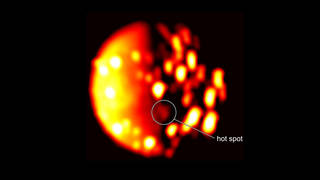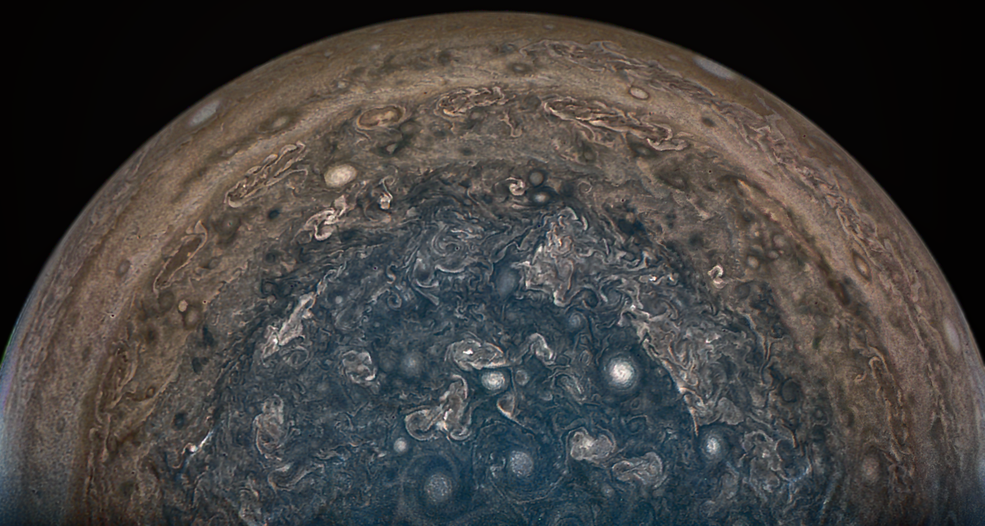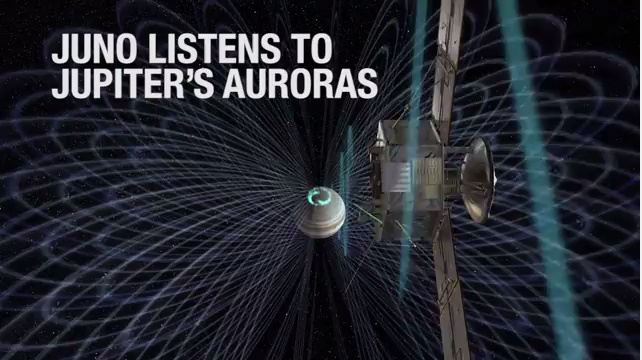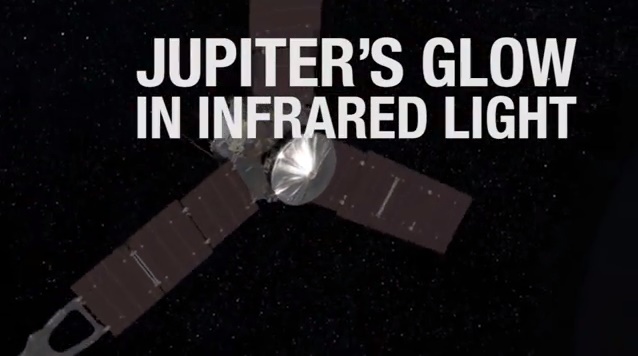NASAが木星探査機ジュノー搭載の観測器のデータ分析から、木星の衛星イオにこれまで知られていなかった火山があるという記事を掲載しました。
以下のNASAの記事によると木星の衛星イオには、これまで約150の火山が発見されていて、今後約250くらいの火山が発見されるだろうとのことです。
なお、このページの下部にNASAが公開しているイオの赤外線観測画像を3つを掲載しましたので、あわせてご参照ください。
NASAのオリジナル記事
NASA Juno Data Indicate Another Possible Volcano on Jupiter Moon Io
Data collected by NASA’s Juno spacecraft using its Jovian InfraRed Auroral Mapper (JIRAM) instrument point to a new heat source close to the south pole of Io that could indicate a previously undiscovered volcano on the small moon of Jupiter. The infrared data were collected on Dec. 16, 2017, when Juno was about 290,000 miles (470,000 kilometers) away from the moon.
NASAの探査機ジュノーに搭載しているJovian InfraRed Auroral Mapper(JIRAM)による観測データは、イオの南極に近い地点で新らたな熱源があることを示しています。これは、木星の小さな衛星イオに今まで知られていなかった火山を示しめしていると言えます。この赤外線データは、ジュノーが衛星イオから約290,000マイル(47万km)離れた地点で2017年12月16日に観測されたものです。
“The new Io hotspot JIRAM picked up is about 200 miles (300 kilometers) from the nearest previously mapped hotspot,” said Alessandro Mura, a Juno co-investigator from the National Institute for Astrophysics in Rome. “We are not ruling out movement or modification of a previously discovered hot spot, but it is difficult to imagine one could travel such a distance and still be considered the same feature.”
「JIRAMにより明らかになったイオの新しいホットスポットは、以前にマップされた最も近いホットスポットから約200マイル(300キロメートル)のところにあります。」と、ローマの天体物理学研究所のジュノー共同研究者であるアレッサンドロ・ムーラ氏は語りました。 「以前に発見されたホットスポットが移動したという可能性を完全に除外しているわけではありませんが、そのような距離を移動して同じような特徴を示すということは考えにくいことです。」
The Juno team will continue to evaluate data collected on the Dec. 16 flyby, as well as JIRAM data that will be collected during future (and even closer) flybys of Io. Past NASA missions of exploration that have visited the Jovian system (Voyagers 1 and 2, Galileo, Cassini and New Horizons), along with ground-based observations, have located over 150 active volcanoes on Io so far. Scientists estimate that about another 250 or so are waiting to be discovered.
ジュノーチームでは、12月16日の木星接近の際に観測したデータと、今後イオに接近した際のJIRAMで観測するデータを引き続き評価していきます。過去のNASAの探査ミッションでは、地上観測や木星とその衛星システムに近づき観測しました(Voyagers 1と2、Galileo、Cassini、New Horizons)が、それにより衛星イオには150以上の活発な火山があることがわかっています。科学者たちは他にも約250以上の火山が発見されるのを待っていると推定しています。
Juno has logged nearly 146 million miles (235 million kilometers) since entering Jupiter’s orbit on July 4, 2016. Juno’s 13th science pass will be on July 16.
木星探査機ジュノーは2016年7月4日に木星を周回する軌道に入ってから約146百万マイル(2億3500万キロメートル)の飛行を記録しています。ジュノーの13回目の科学探査は7月16日に行われる予定です。
Juno launched on Aug. 5, 2011, from Cape Canaveral, Florida. During its mission of exploration, Juno soars low over the planet’s cloud tops — as close as about 2,100 miles (3,400 kilometers). During these flybys, Juno is probing beneath the obscuring cloud cover of Jupiter and studying its auroras to learn more about the planet’s origins, structure, atmosphere and magnetosphere.
JPL manages the Juno mission for the principal investigator, Scott Bolton, of Southwest Research Institute in San Antonio. The Juno mission is part of the New Frontiers Program managed by NASA’s Marshall Space Flight Center in Huntsville, Alabama, for the Science Mission Directorate. The Italian Space Agency (ASI), contributed two instruments, a Ka-band frequency translator (KaT) and the Jovian Infrared Auroral Mapper (JIRAM). Lockheed Martin Space, Denver, built the spacecraft. JPL is a division of Caltech in Pasadena, California.
More information on the Juno mission is available at:https://www.nasa.gov/juno
https://www.missionjuno.swri.edu
The public can follow the mission on Facebook and Twitter at:https://www.facebook.com/NASAJuno
Tweets by NASAJuno
News Media Contacts:
DC Agle
Jet Propulsion Laboratory, Pasadena, Calif.
818-393-9011
agle@jpl.nasa.gov
JoAnna Wendel
NASA Headquarters, Washington
202-358-1003
joanna.r.wendel@nasa.gov
Deb Schmid
Southwest Research Institute, San Antonio
210-522-2254
dschmid@swri.org
Last Updated: July 14, 2018
Editor: Jon Nelson
NASAが公開しているイオの赤外線観測画像を3つ
This annotated image highlights the location of the new heat source close to the south pole of Io. The image was generated from data collected on Dec. 16, 2017, by the Jovian Infrared Auroral Mapper (JIRAM) instrument aboard NASA’s Juno mission when the spacecraft was about 290,000 miles (470,000 kilometers) from the Jovian moon. The scale to the right of image depicts of the range of temperatures displayed in the infrared image. Higher recorded temperatures are characterized in brighter colors – lower temperatures in darker colors.
この注釈付き画像は、イオの南極に近い新しいホットスポットの位置をわかりやすく示したものです。この画像は、NASAの木星の衛星探査機ジュノーに搭載された赤外線オーロラ・マッパー(JIRAM)により木星の衛星イオから約290,000マイル(47.7万キロメートル)の地点から2017年12月16日に観測したデータにより作成されました。画像の右のスケールは、赤外線画像に表示される温度の範囲を示しています。観測された温度で高温程より明るい色で表現されています – より暗い色の部分はより低い温度ということです。
This infrared image of the southern hemisphere of Jupiter’s moon Io was derived from data collected by the Jovian Infrared Auroral Mapper (JIRAM) instrument aboard NASA’s Juno spacecraft on Dec. 16, 2017, when the spacecraft was about 290,000 miles (470,000 kilometers) from the Jovian moon. In this infrared image, the brighter the color the higher the temperature recorded by JIRAM.
木星の衛星イオの南半球の赤外線画像は、2017年12月16日にNASAの木星探査機ジュノーに搭載されたオーロラマッパー(JIRAM)のデータから得られたもので、探査機は衛星から約290,000の位置にありました。この赤外線画像では、色が明るくなるほどJIRAMによって記録される温度が高くなっていることを表しています。
This annotated image highlights the location of the new heat source in the southern hemisphere of the Jupiter moon Io. The image was generated from data collected on Dec. 16, 2017, by the Jovian Infrared Auroral Mapper (JIRAM) instrument aboard NASA’s Juno mission when the spacecraft was about 290,000 miles (470,000 kilometers) from the Jovian moon. In this infrared image, the brighter the color the higher the temperature recorded by JIRAM.
この注釈付き画像は、木星の衛星イオの南半球における新しいホットスポットの位置を示しています。この画像は、NASAの木星探査機ジュノーに搭載した赤外線オーロラ・マッパー(JIRAM)、木星の衛星イオから約290,000マイル(47.7万キロメートル)の地点から2017年12月16日に観測したデータから作成しました。この赤外線画像では、色が明るくなるほどJIRAMによって観測された温度が高いことを表しています。













